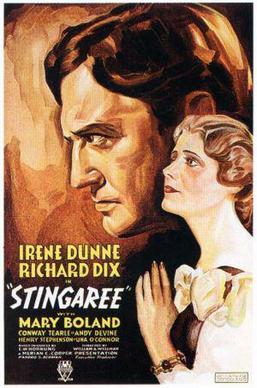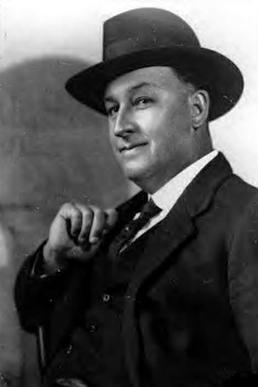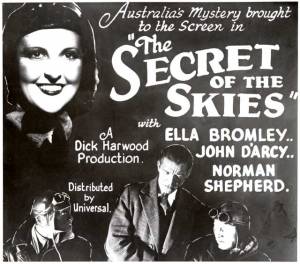Related Research Articles

John Villiers Farrow, KGCHS was an Australian film director, producer, and screenwriter. Spending a considerable amount of his career in the United States, in 1942 he was nominated for the Academy Award for Best Director for Wake Island, and in 1957 he won the Academy Award for Best Adapted Screenplay for Around the World in Eighty Days. He had seven children by his wife, actress Maureen O'Sullivan, including actress Mia Farrow.

Cinesound Productions Pty Ltd was an Australian feature film production company. Established in June 1931, Cinesound developed out of a group of companies centred on Greater Union Theatres that covered all facets of the film process, from production to distribution and exhibition. Cinesound Productions established a film studio as a subsidiary of Greater Union Theatres Pty Ltd based on the Hollywood model. The first production was On Our Selection (1932), which was an enormous financial success.

Stingaree is an American pre-Code romantic drama film directed by William A. Wellman released by RKO Radio Pictures in 1934. The film was based on a 1905 novel by Ernest William Hornung. Set in Australia, it stars Irene Dunne as Hilda Bouverie and Richard Dix as Stingaree. Hollywood had previously filmed the Hornung story as serials in 1915 and 1917, starring True Boardman.
His Royal Highness is a 1932 Australian musical film directed by F. W. Thring, also known as His Loyal Highness, starring George Wallace in his feature film debut. It was the first Australian film musical.

Raymond Longford was a prolific Australian film director, writer, producer, and actor during the silent era. Longford was a major director of the silent film era of the Australian cinema. He formed a production team with Lottie Lyell. His contributions to Australian cinema with his ongoing collaborations with Lyell, including The Sentimental Bloke (1919) and The Blue Mountains Mystery (1921), prompted the Australian Film Institute's AFI Raymond Longford Award, inaugurated in 1968, to be named in his honour.
A Ticket in Tatts is a 1934 musical comedy film starring popular stage comedian George Wallace as an accident-prone stablehand. It was the last of three films Wallace made for F. W. Thring.
Into the Straight is a 1949 Australian horse racing melodrama directed by T. O. McCreadie.
Splendid Fellows is a 1934 Australian film from director Beaumont Smith about an Englishman who comes to Australia. The cast includes Eric Colman, brother of Ronald Colman, and Sir Charles Kingsford Smith, who has a cameo as himself. It was Smith's last film.
Alexander Roy Harwood (1897–1980), better known as A. R. Harwood, or Dick Harwood, was an Australian film director and producer who also worked in exhibition. He was inspired to become a filmmaker when he was posted to Tahiti to work for an insurance company and watched the shooting of Never the Twain Shall Meet (1925). He returned to Australia and produced and directed The Man Who Forgot (1927).

The Secret of the Skies is a 1934 Australian film directed by A. R. Harwood about a bank robber who crashes an aircraft in remote bush. The story was inspired by the 1931 disappearance of the Australian National Airways aircraft the Southern Cloud.
Spur of the Moment is a 1931 Australian film directed by A. R. Harwood. It was one of the first Australian talking movies.
Diggers in Blighty is a 1933 Australian film starring and directed by Pat Hanna. Hanna decided to direct this film himself after being unhappy with how F. W. Thring had handled Diggers (1931).
The Sentimental Bloke is a 1932 Australian film directed by F. W. Thring and starring Cecil Scott and Ray Fisher. It is an adaptation of the 1915 novel Songs of a Sentimental Bloke by C. J. Dennis, which had previously been filmed in 1919.
Sheepmates was a proposed Australian film from director F. W. Thring based on a 1931 novel by William Hatfield. It commenced filming in 1933 but was abandoned.
Showgirl's Luck is a 1931 Australian musical directed by Norman Dawn. It was the first Australian full talking film.

The Grey Glove is a 1928 Australian silent film based on a newspaper serial by E. V. Timms.

The Haunted Barn is a short 1931 Australian comedy film produced by F.W. Thring directed by Gregan McMahon. It was one of the first productions by Thring's Efftee Studios. The film was produced to support of the feature Diggers (1931) and shown on the same bill.
Out of the Shadows was an unfinished 1931 feature film from A. R. Harwood. He made it after a number of years of working in distribution with the intention of producing Australia's first talking motion picture. The script was by J. Summers, "a Victorian who has had experience in Hollywood".

Minnie Everett was an Australian ballet-mistress and producer, closely associated with the J. C. Williamson's company. She was the world's first woman producer of Gilbert and Sullivan operettas.
Lance Fairfax was a singer and actor from New Zealand, classed as a light baritone, who had a substantial career in Australia.
References
- ↑ "AUSTRALIAN TALKIES". The West Australian . Perth. 16 October 1931. p. 2. Retrieved 5 April 2012– via National Library of Australia.
- ↑ "CINEMA NOTES". The Mercury . Hobart, Tasmania. 6 November 1931. p. 5. Retrieved 5 April 2012– via National Library of Australia.
- ↑ Andrew Pike and Ross Cooper, Australian Film 1900–1977: A Guide to Feature Film Production, Melbourne: Oxford University Press, 1998 p154
- ↑ "No. 1. Our Chances for World Markets". Table Talk . Melbourne. 17 August 1933. p. 7. Retrieved 16 March 2015– via National Library of Australia.
- ↑ "AUSTRALIAN TALKIES". The Brisbane Courier . 9 November 1931. p. 13. Retrieved 5 April 2012– via National Library of Australia.
- ↑ "THE PICTURES". The Argus . Melbourne. 28 September 1931. p. 10. Retrieved 5 April 2012– via National Library of Australia.